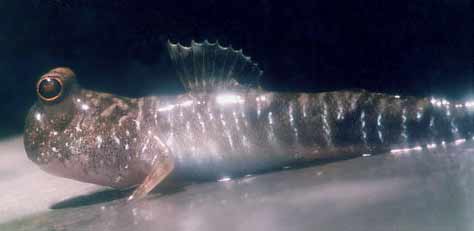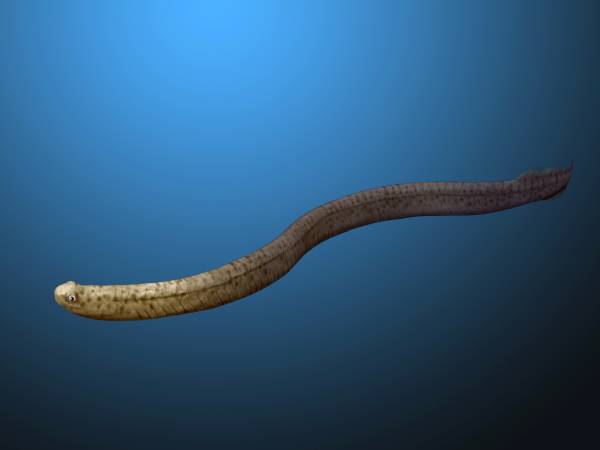|
Early Tetrapod Trackways
There are several cases of reported trackways of the earliest land-going vertebrates, also known as tetrapods. These trackways provide crucial insights to the study of the transition of aquatic to terrestrial lifestyles in vertebrate evolution. Such fossils help to illuminate not only the timing of this keystone transition of evolutionary history but also what the earliest forms of tetrapod locomotion may have entailed. Occurrences Victoria, Australia A set of three trackways was found within a single sandstone layer of the Genoa River Formation of Victoria, Australia. The Genoa River Formation is a very fine grained purplish-brown non-marine sandstone considered Late Devonian in age based on fern-like plant fossils within the bed and stratigraphic correlation. The tracks preserve four or more impressions each. Each trackway has a roughly parallel structure to the left and right tracks. None of the impressions are reported to include evidence of body dragging, though one in ... [...More Info...] [...Related Items...] OR: [Wikipedia] [Google] [Baidu] |
Fossil Track
A fossil track or ichnite (Greek "''ιχνιον''" (''ichnion'') – a track, trace or footstep) is a fossilized footprint. This is a type of trace fossil. A fossil trackway is a sequence of fossil tracks left by a single organism. Over the years, many ichnites have been found, around the world, giving important clues about the behaviour (and foot structure and stride) of the animals that made them. For instance, multiple ichnites of a single species, close together, suggest 'herd' or 'pack' behaviour of that species. Combinations of footprints of different species provide clues about the interactions of those species. Even a set of footprints of a single animal gives important clues, as to whether it was bipedal or quadrupedal. In this way, it has been suggested that some pterosaurs, when on the ground, used their forelimbs in an unexpected quadrupedal action. Special conditions are required, in order to preserve a footprint made in soft ground (such as an alluvial plain or a f ... [...More Info...] [...Related Items...] OR: [Wikipedia] [Google] [Baidu] |
Radioisotopic Dating
Radiometric dating, radioactive dating or radioisotope dating is a technique which is used to date materials such as rocks or carbon, in which trace radioactive impurities were selectively incorporated when they were formed. The method compares the abundance of a naturally occurring radioactive isotope within the material to the abundance of its decay products, which form at a known constant rate of decay. The use of radiometric dating was first published in 1907 by Bertram Boltwood and is now the principal source of information about the absolute age of rocks and other geological features, including the age of fossilized life forms or the age of Earth itself, and can also be used to date a wide range of natural and man-made materials. Together with stratigraphic principles, radiometric dating methods are used in geochronology to establish the geologic time scale. Among the best-known techniques are radiocarbon dating, potassium–argon dating and uranium–lead dating. By allo ... [...More Info...] [...Related Items...] OR: [Wikipedia] [Google] [Baidu] |
Mudskipper
Mudskippers are any of the 23 extant species of amphibious fish from the subfamily Oxudercinae of the goby family Oxudercidae. They are known for their unusual body shapes, preferences for semiaquatic habitats, limited terrestrial locomotion and jumping, and the ability to survive prolonged periods of time both in and out of water. Mudskippers can grow up to long, and most are a brownish green colour that range anywhere from dark to light. During mating seasons, the males will also develop brightly coloured spots in order to attract females, which can be red, green or blue. Unlike other fish, the mudskipper's eyes protrude from the top of its flat head. Their most noticeable feature however is their side pectoral fins that are located more forward and under their elongated body. These fins are jointed and function similarly to limbs, which allow the mudskipper to crawl from place to place. Although having the typical body form of any other gobiid fish, these front fins allow t ... [...More Info...] [...Related Items...] OR: [Wikipedia] [Google] [Baidu] |
Ichthyostega
''Ichthyostega'' (from el, ἰχθῦς , 'fish' and el, στέγη , 'roof') is an extinct genus of limbed tetrapodomorphs from the Late Devonian of Greenland. It was among the earliest four-limbed vertebrates in the fossil record, and was one of the first with weight-bearing adaptations for terrestrial locomotion. ''Ichthyostega'' possessed lungs and limbs that helped it navigate through shallow water in swamps. Although ''Ichthyostega'' is often labelled a 'tetrapod' due to the possession of limbs and fingers, it evolved long before true crown group tetrapods, and could more accurately be referred to as a stegocephalian or stem tetrapod. Likewise, while undoubtedly of amphibian build and habit, it is not considered a true member of the group in the narrow sense, as the first modern amphibians (members of the group Lissamphibia) appeared in the Triassic Period. Until finds of other early stegocephalians and closely related fishes in the late 20th century, ''Ichthyostega'' ... [...More Info...] [...Related Items...] OR: [Wikipedia] [Google] [Baidu] |
Biostratigraphy
Biostratigraphy is the branch of stratigraphy which focuses on correlating and assigning relative ages of rock strata by using the fossil assemblages contained within them.Hine, Robert. “Biostratigraphy.” ''Oxford Reference: Dictionary of Biology'', 8th ed., Oxford University Press, 2019. The primary objective of biostratigraphy is ''correlation'', demonstrating that a particular horizon in one geological section represents the same period of time as another horizon at a different section. Fossils within these strata are useful because sediments of the same age can look completely different, due to local variations in the sedimentary environment. For example, one section might have been made up of clays and marls, while another has more chalky limestones. However, if the fossil species recorded are similar, the two sediments are likely to have been laid down around the same time. Ideally these fossils are used to help identify biozones, as they make up the basic biostratigraphy ... [...More Info...] [...Related Items...] OR: [Wikipedia] [Google] [Baidu] |
Conodont
Conodonts ( Greek ''kōnos'', " cone", + ''odont'', " tooth") are an extinct group of agnathan (jawless) vertebrates resembling eels, classified in the class Conodonta. For many years, they were known only from their tooth-like oral elements, which are usually found in isolation and are now called conodont elements. Knowledge about soft tissues remains limited. They existed in the world's oceans for over 300 million years, from the Cambrian to the beginning of the Jurassic. Conodont elements are widely used as index fossils, fossils used to define and identify geological periods. The animals are also called Conodontophora (conodont bearers) to avoid ambiguity. Discovery and understanding of conodonts The teeth-like fossils of the conodont were first discovered by Heinz Christian Pander and the results published in Saint Petersburg, Russia, in 1856. The name ''pander'' is commonly used in scientific names of conodonts. It was only in the early 1980s that the first fossil evi ... [...More Info...] [...Related Items...] OR: [Wikipedia] [Google] [Baidu] |
Middle Devonian
The Devonian ( ) is a geologic period and system of the Paleozoic era, spanning 60.3 million years from the end of the Silurian, million years ago (Mya), to the beginning of the Carboniferous, Mya. It is named after Devon, England, where rocks from this period were first studied. The first significant adaptive radiation of life on dry land occurred during the Devonian. Free-sporing vascular plants began to spread across dry land, forming extensive forests which covered the continents. By the middle of the Devonian, several groups of plants had evolved leaves and true roots, and by the end of the period the first seed-bearing plants appeared. The arthropod groups of myriapods, arachnids and hexapods also became well-established early in this period, after starting their expansion to land at least from the Ordovician period. Fish reached substantial diversity during this time, leading the Devonian to often be dubbed the Age of Fishes. The placoderms began dominating al ... [...More Info...] [...Related Items...] OR: [Wikipedia] [Google] [Baidu] |
Trace Fossil
A trace fossil, also known as an ichnofossil (; from el, ἴχνος ''ikhnos'' "trace, track"), is a fossil record of biological activity but not the preserved remains of the plant or animal itself. Trace fossils contrast with body fossils, which are the fossilized remains of parts of organisms' bodies, usually altered by later chemical activity or mineralization. The study of such trace fossils is ichnology and is the work of ichnologists. Trace fossils may consist of impressions made on or in the substrate by an organism. For example, burrows, borings ( bioerosion), urolites (erosion caused by evacuation of liquid wastes), footprints and feeding marks and root cavities may all be trace fossils. The term in its broadest sense also includes the remains of other organic material produced by an organism; for example coprolites (fossilized droppings) or chemical markers (sedimentological structures produced by biological means; for example, the formation of stromatolites). ... [...More Info...] [...Related Items...] OR: [Wikipedia] [Google] [Baidu] |
Holy Cross Mountains
Sacred describes something that is dedicated or set apart for the service or worship of a deity; is considered worthy of spiritual respect or devotion; or inspires awe or reverence among believers. The property is often ascribed to objects (a " sacred artifact" that is venerated and blessed), or places (" sacred ground"). French sociologist Émile Durkheim considered the dichotomy between the sacred and the profane to be the central characteristic of religion: "religion is a unified system of beliefs and practices relative to ''sacred things'', that is to say, things set apart and forbidden." Durkheim, Émile. 1915. ''The Elementary Forms of the Religious Life''. London: George Allen & Unwin. . In Durkheim's theory, the sacred represents the interests of the group, especially unity, which are embodied in sacred group symbols, or using team work to help get out of trouble. The profane, on the other hand, involve mundane individual concerns. Etymology The word ''sacred'' des ... [...More Info...] [...Related Items...] OR: [Wikipedia] [Google] [Baidu] |
Wojciechowice Formation (east-central Poland)
{{geodis ...
Wojciechowice may refer to the following places in Poland: *Wojciechowice, Lower Silesian Voivodeship (south-west Poland) * Wojciechowice, Jędrzejów County in Świętokrzyskie Voivodeship (south-central Poland) *Wojciechowice, Opatów County in Świętokrzyskie Voivodeship (south-central Poland) *Wojciechowice, Ostrowiec County in Świętokrzyskie Voivodeship (south-central Poland) *Wojciechowice, Masovian Voivodeship Wojciechowice () is a village in the administrative district of Gmina Góra Kalwaria __NOTOC__ Gmina Góra Kalwaria is an urban-rural gmina (administrative district) in Piaseczno County, Masovian Voivodeship, in east-central Poland. Its seat is ... [...More Info...] [...Related Items...] OR: [Wikipedia] [Google] [Baidu] |
Fluvial
In geography and geology, fluvial processes are associated with rivers and streams and the deposits and landforms created by them. When the stream or rivers are associated with glaciers, ice sheets, or ice caps, the term glaciofluvial or fluvioglacial is used. Fluvial processes Fluvial processes include the motion of sediment and erosion or deposition on the river bed. The movement of water across the stream bed exerts a shear stress directly onto the bed. If the cohesive strength of the substrate is lower than the shear exerted, or the bed is composed of loose sediment which can be mobilized by such stresses, then the bed will be lowered purely by clearwater flow. In addition, if the river carries significant quantities of sediment, this material can act as tools to enhance wear of the bed ( abrasion). At the same time the fragments themselves are ground down, becoming smaller and more rounded ( attrition). Sediment in rivers is transported as either bedload (the coar ... [...More Info...] [...Related Items...] OR: [Wikipedia] [Google] [Baidu] |





